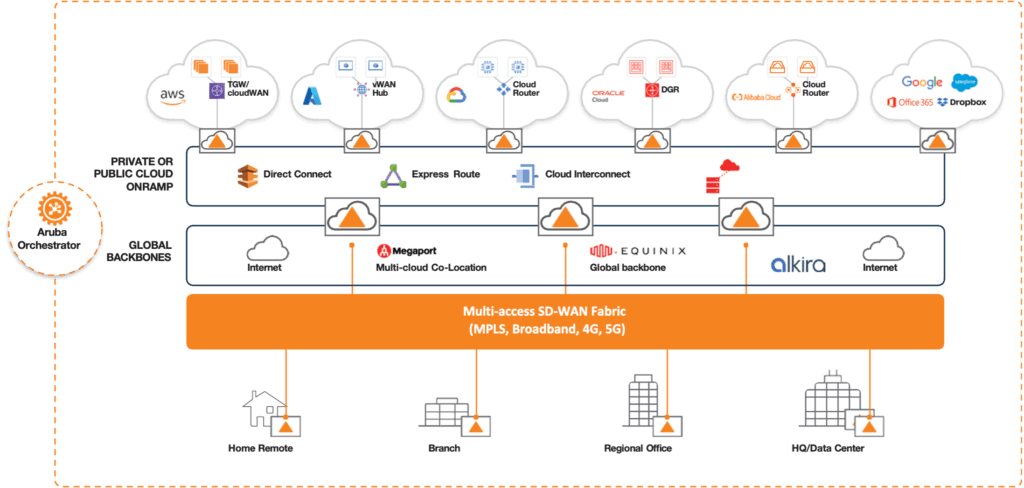
I just attended AWS Re:Invent 2022 in person last week ago, and with more than 60,000 live participants, it’s more apparent than ever that enterprise IT leaders are embracing public cloud platforms as part of their digital transformation. The reality is that for most enterprises, there is a recognition that in the post-pandemic era, IT will have to support a hybrid work environment that enables employees to access any public-hosted or SaaS cloud application, without compromising the user experience or security.
Although AWS continues to be the dominant public cloud platform for many enterprises, an increasing number of enterprises are selecting two or more public cloud platforms for a number of business and technology related reasons. This is supported by the market share growth of Microsoft Azure and Google Cloud.
In fact, a recent 2022 Futuriom multi-cloud networking survey confirms that networking is seen as a key enabler needed for enterprises to implement a full move to multi-cloud and hybrid cloud strategies. Of those surveyed, 81% indicated that multi-cloud networking is expected to help simplify or accelerate hybrid or multi-cloud adoption.
What role does SD-WAN play in helping enterprises accelerate their implementation of a multi-cloud networking strategy? Can SD-WAN make it easier for enterprises to connect to multiple cloud providers and integrate to new cloud services like AWS CloudWAN or Microsoft Virtual WAN?
Initially, SD-WAN was limited to applications egressing from branch locations. In the past several years, enterprise SD-WAN requirements have evolved to include direct branch-cloud connectivity. Multi-cloud SD-WAN networking provides a direct connectivity to the cloud, thus extending SD-WAN capabilities like application intelligence, visibility and control to the last mile in the cloud. In the past several years, this has expanded to include extending SD-WAN into the cloud by deploying virtual SD-WAN appliances within public cloud providers infrastructure.
An example of a SD-WAN multi-cloud networking platform is Aruba EdgeConnect SD-WAN, which extends branch site access to cloud services for enterprise branch office employees by providing direct connectivity to the major public clouds (e.g., AWS, Google Cloud, Microsoft Azure, Oracle Cloud and Alibaba Cloud) and to many private cloud providers.
The EdgeConnect SD-WAN multi-cloud platform supports a global SD-WAN fabric that enables users to interconnect from any EdgeConnect SD-WAN enabled-edge location to applications across multiple clouds ensuring end-to-end application performance across this fabric.
Similarly, organizations can combine the management of their branch offices to WAN connectivity to the cloud applications that simplify operations significantly. SD-WAN platforms should also support the flexibility for connectivity to middle-mile cloud exchange platforms such as Equinix, Megaport, and Alkira which can further simplify and aggregate the branch-multi-cloud connectivity infrastructure as shown in Figure 1.

Figure 1: Flexible Multi-Cloud Deployment with EdgeConnect Enterprise SD-WAN
What is also important to understand is that SD-WAN multi-cloud networking is also about leveraging Application Programming Interfaces (APIs) to build automated orchestration and visibility of cloud application workloads from a SD-WAN platform. EdgeConnect SD-WAN has been integrated with leading public cloud providers backbone networks such as AWS CloudWAN, Microsoft Virtual WAN (vWAN) or Google Network Connectivity Center and also middle-mile cloud exchanges such as Equinix, Megaport and Alkira.
How can enterprises benefit from SD-WAN multi-cloud?
NETSCOUT is an Aruba customer that is leveraging the EdgeConnect SD-WAN integration with AWS CloudWAN to help NETSCOUT connect remote branch offices from the WAN to the data center centers for their production, management and test environments using Aruba EdgeConnect.
NETSCOUT IT has been using the Aruba EdgeConnect SD-WAN solution across AWS Cloud WAN to connect its own Westford, Massachusetts, data center and remote branch offices to production, management, and test virtual private clouds (VPCs) in AWS
The Aruba EdgeConnect SD-WAN platform enables customers to build a unified WAN edge that is business-driven, delivers a high-quality experience, and adapts to changing business needs and network conditions. Its architectural model utilizes virtual WAN overlays based on business requirements (business intent overlays) for each class of application.
This example of an enterprise SD-WAN cloud deployment could evolve into SD-WAN multi-cloud networking if an enterprise wants to add a second or third cloud provider for additional workloads or wants to migrate some existing workloads from AWS to another public cloud provider. The existing EdgeConnect SD-WAN platforms at every branch location can easily handle these type of use cases without having to change or add any additional SD-WAN software licenses at each site.
As more enterprises migrate to a multi-cloud network environment, IT staff should be aware that the EdgeConnect SD-WAN platform can simplify deployment of virtual instances in any of the major public clouds, support automated orchestration and secure branch connectivity directly to public cloud providers’ global backbone and offer the flexibility to include WAN optimization, when needed to optimize bandwidth on cloud connectivity for critical applications.
So if you are ready to embark on your multi-cloud networking journey, remember that choosing the right SD-WAN platform can help make it easier to integrate to multiple clouds. To learn more about how Aruba EdgeConnect SD-WAN platform can help with multi-cloud networking, here are resources to reference:




